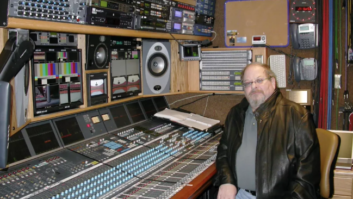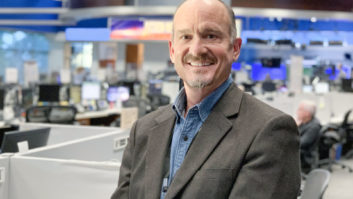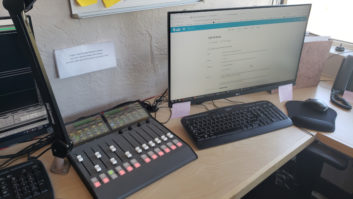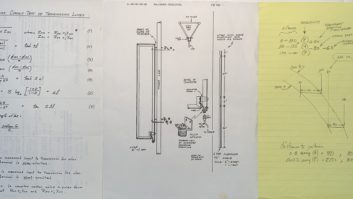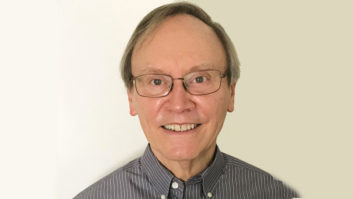An AM Directional Kind of Engineer
(click thumbnail)Steve DavisStephen Davis started his broadcast career as an engineer at KAMR(TV) in Amarillo, Texas in 1977. There he made friends with an engineer who worked at a radio station who introduced him to the GM. Davis began moonlighting as an engineer and DJ at station KIXZ(AM) – a station Clear Channel now owns.
He moved through TV jobs in Pueblo, Colo., and Tulsa, Okla., and in 1982 signed on as chief engineer at a Tulsa AM/FM combo owned by a small company known as Clear Channel Broadcasting, which at that time owned six radio stations and was privately held.
Davis’ first task was to install a new four-tower AM array in Tulsa on 1300 kHz. Soon came Docket 80-90. Clear Channel started adding stations and building towers to move them in. The broadcaster went public in 1984.
He oversaw design and construction of a new multi-station tower site and began to go on the road helping engineers in the growing company to build transmitter facilities, and move/upgrade their signals. He was promoted to corporate director of engineering while still retaining local DOE responsibilities.
After the 1996 Telecom Act, Clear Channel joined other groups in acquiring stations at a breakneck pace. He was promoted to vice president of engineering and played various roles in the budgeting, design, and oversight of close to 100 studio projects since.
The 49-year-old Davis says he is proud of a project management database he developed for the company’s internal intranet, where project descriptions, budgets, timelines, schematic designs, a record of all invoices paid against the project to date, and correspondence are posted and updated.
“Everyone can see only projects in his or her area, whether a region, a state, or a single market or station,” said Davis. “If we order equipment at the corporate level, we log that so the station knows it. If there will be a cost overrun or delay, our architects log it so everyone is in the loop.”
He said he’s always looking for ways to improve company systems, to make the stations’ interaction with them easier and less time-consuming.
Davis and his wife reside in Tulsa and have two daughters, both in college. He enjoys motorcycle riding, sound recording/engineering and mixing a live band on a local radio show on Friday mornings.
For a while, he was the chief engineer at Natura Digital Recording Studios in Natura, Okla., owned by former Bob Seger drummer Dave Teegarden. Davis also enjoys model railroading.
Davis is an SBE Certified Senior Radio Engineer, and holds a lifetime FCC General Class License (converted from the old First Class License). He has served as president and treasurer of the Northeast Oklahoma SBE Chapter 56 and on on the NAB’s FM Transmission Committee, having a part in formulating a position on the FM directional antenna rules. He serves on NAB’s Engineering Program Committee.
— Leslie StimsonAt Clear Channel, Steve Davis Keeps Radio Engineering Organized
TULSA, Okla. Steve Davis remembers when Clear Channel had six radio stations. Now, it has about 1,200 stations and some 800 engineers – probably the U.S. commercial radio industry’s largest staff of technical employees.
After his recent promotion, Davis, who has been with the company for 23 years, oversees engineering management for the company; Jeff Littlejohn, senior vice president of distribution development, now focuses on new technologies for the company.
In addition to new responsibilities, Davis continues to manage the capital budget for engineering and FCC/regulatory issues. RW reported Littlejohn’s new responsibilities recently (June 8). Here, News Editor/Washington Bureau Chief Leslie Stimson talks with Davis about the changes in his job and the technical issues facing radio.
RW: You’re juggling lots of new duties. What are those and what is your new title?
Davis: Officially, senior vice president, engineering and capital management. I have taken on Jeff’s former engineering administration duties: primarily, management of the regional engineering VPs and leadership of the radio group’s engineering efforts.
Some other duties that I’ve taken on include review of studio and tower leases, working with other group chiefs on cooperative deals such as mutual tower projects and interfacing with tower space vendors. … I work with our engineering VPs on identifying signal moves and upgrades and helping to determine which are worth pursuing, and tracking these through finality.
I provide guidance and set technical standards for our stations, funnel suggestions to manufacturers for meeting our technical requirements; and evaluate equipment for suitability for our use, typically in cooperation with our regional VPs of engineering. I also work with various FCC attorneys in preparing, editing, approving and signing pleadings, responses, petitions and other similar documents of a technical regulatory nature that are to be filed with the FCC.
RW: What duties do you retain, which ones are passed on?
Davis: I have passed day-to-day administration and oversight of the capital budget to the 10 regional VPs of engineering. I still provide general oversight and guidance, and monthly budget tracking, forecasting and reporting to senior management.
But each RVPE has a budget to work within; and as long as they’re hitting that I generally don’t interfere with them. I still put together the overall capital budget every year and adjust it as needed, and during the year I’ll move funds between the regions to respond to emerging critical needs, emergencies, etc.
Drawing upon the submissions of the RVPEs and Jeff Littlejohn’s needs for distribution development, I present a consolidated three-year capital plan to senior management. So what used to be my sole responsibility is now a collaborative task.
Also, I used to handle negotiations with vendors for equipment, and purchasing/bidding of capital equipment. The lion’s share of that, except for certain new or critical technologies, is now handled by a new hire, Lucas Wrenn, our capital purchasing coordinator.
I continue to have responsibility, in partnership with our RVPEs, for regulatory compliance, making sure that projects are constructed before permits expire, STAs are timely filed, etc. I oversee a team based in Tulsa that checks our stations’ public files and helps them stay compliant.
I have involvement in the original stages – such as budget development, real estate broker selection and negotiations, determination of needed square footage, lease evaluation, site selection, recommending whether or not a project should proceed, and when, of studio consolidation projects – but I have passed the day-to-day project management responsibilities for those projects, once approved and property has been secured, to our RVPEs. …
RW: Do you and Jeff Littlejohn work together on some projects, such as IBOC projects, at all?
Davis: Absolutely. I report to Jeff, he’s my boss. Our company has realized that rather than just being in the “tall towers in big fields” business, we’re in the content and distribution business. Jeff is the visionary who is exploring new and innovative ways to distribute compelling content to end-users.
I was promoted mainly to take the load of day-to-day engineering administrative matters and personnel management off of Jeff’s shoulders, so he would be free to explore new ideas, meet and negotiate with other parties who can partner with us in distribution of our content to the widest possible audience, and generally visualize and paint the “big picture.” I’m in charge of executing Jeff’s vision, putting the people and capital resources in place to achieve that.
For example, Jeff tells me what stations to roll out IBOC on, and assigns the priorities. I make sure we have the personnel and materiel to accomplish that.
RW: Now that the company has committed to a speedy IBOC conversion of most of its stations, how has that changed your job? How many stations have converted so far?
Davis: I’ve had to spend a fair amount of time learning, getting up to speed, with the technology and the challenges inherent in implementing it. There’s much more to it than just a new exciter or second transmitter.
One change in my job is the sheer magnitude of transmitter and antenna projects due to IBOC. We always had some of these each year, to maximize our signals and uptime and stay competitive. But when you add the normal volume of RF upgrade projects, to rolling out HD Radio on over a hundred stations in a year, the project management piece, scheduling and purchasing equipment, lining up installers, etc., becomes a significant challenge.
Our RVPEs are the driving force behind the HD rollout and are working very hard to meet a very aggressive schedule. We have had a bit of a learning curve; and in many cases the manufacturers’ equipment was not quite “ready for prime time.” The equipment, and our understanding of the challenges involved in properly deploying it, continues to improve.
Additionally, beyond the installation and alignment of the HD equipment itself, there is often a need for significant improvements to our existing transmitting facilities. A lot of things that didn’t matter too much, such as group delay in the output network of a transmitter (especially important with mid-level or “split-level” combining), or load symmetry through plus and minus 10 kHz for an AM station, can have a significant impact now.
It’s not just the magnitude of the variation of the load with frequency that matters now, we’re looking for Hermetian Symmetry in the load for AM HD. Our monthly engineering management conference calls are a lot more exciting and interesting than they once were, as there are numerous new issues brought to light, discussed, and often resolved.
Our projection (shows) we will have converted 197 radio stations as of July 1. …
RW: What goodies to go along with IBOC implementation is CCR considering, such as multicasting, surround sound, other kinds of data initiatives …
Davis: We are actively investigating, pursuing, and at times testing, many of these sorts of technologies. Clearly multicasting and surround sound have promise. I’d like to see the surround sound format/coding debate resolved soon.
RW: How does the fact that the company may implement those in some markets affect you?
Davis: We will have to become much better versed in data connectivity and other issues traditionally thought of as “IT.” With program-associated data and our RDS/Traffic Message Channel data project, we already are.
We’re looking at bi-directional connectivity to transmitter sites as an option, and how to ensure quality of service by partitioning bandwidth between studios and transmitter sites. So, for example, a PC at the transmitter site surfing the Internet doesn’t cause loss of quality of more critical data in the pipeline. …
RW: Tells us about the part of your job that involves FCC filings. Are you coordinating the engineering portion of those?
Davis: Prior to the Jacor and AMFM mergers, when I was VP/engineering for the “pre-merger” Clear Channel, one of my duties was to personally prepare most of our FCC filings, especially applications for construction permits (station moves and upgrades), and licenses, and multiple ownership studies required to support station acquisitions. Initially I did this start to finish: the engineering portion, technical exhibits and maps, and the legal/applicant portions.
After Congress passed the Telecommunications Act in 1996, the volume of filings, especially ownership studies related to station acquisitions, just became too much to handle. So I hired a broadcast engineer, Troy Langham, who had done some FCC filings and was a bright individual as well as a seasoned broadcast engineer, and brought him on board to help with the load.
Now Troy heads up our FCC filing department as FCC engineering supervisor, with a recent hire, Jeff Frey, brought on recently to handle AM 302s, FM auxiliary 301s, antenna structure registrations, FAA 7460s and other filings under Troy’s guidance. Troy and Jeff do all the engineering applications and exhibits, much as a consulting house would do, and we now use attorneys based in D.C. to complete the legal and ownership portions and file these for us.
We also have Steven Slocum doing Part 101 coordination and 601 applications as required under the new Broadcast Auxiliary Services rules. Given the volume of BAS filings we do, it just made a lot more sense to bring this in-house.
I still do some FCC filings, ownership studies and applications, to handle heavy workloads or if the situation is particularly challenging. And I usually provide quick evaluations to senior management of the ownership rules and whether we can own a station we may be seeking to acquire, under the new media ownership rules. …
RW: The FCC is due to come out later this year with its further notice on IBOC. What do you hope is included in that?
Davis: Different modes of operation, including multicasting, permitted without “experimental authorization.”
The ability to use separate antennas as a means of transmitting HD, without having to request special temporary authority, and renewing that every six months.
Codification of the AM HD mask.
And approval of nighttime AM IBOC operation, and along with that, a definition of “unacceptable interference” – so we have a bright line by which to determine whether or not a nighttime IBOC AM operation is in fact causing interference to another station. …
RW: A while ago CCR reorganized its engineering structure and named several regional engineers. How is that system working out?
Davis: Actually Jeff Littlejohn brought the concept of regional engineering managers with him from AMFM, where he was the VP/engineering just prior to merging with Clear Channel. So when we merged, Jeff was responsible for managing them.
He augmented his former AMFM team with engineers from Clear Channel, and built the team I’m fortunate to have now. So Jeff did all the heavy lifting on that. I continue to fine-tune and adjust that team, their geographic areas of responsibility, etc., as needs change.
Two years ago we elevated the regional engineering managers to the regional vice president level. I think it’s helpful that they have that status when dealing with station general managers and program directors. It is reflective of the importance Clear Channel, and our senior management, including John Hogan (chief executive officer of Clear Channel Radio), attach to engineering, and top engineering talent.
With over 1,200 radio stations in the group, each of our 10 regional engineering VPs has an average of 120 stations under his purview – more stations than I had responsibility for when I was director of engineering for all of Clear Channel prior to 1996!
The RVPEs are primarily there to provide guidance, and mentor, engineers in the various markets. They have been instrumental in providing help, including hands-on installation assistance or management as needed, with the IBOC rollouts, and they certify that each IBOC signal launched is within the spectral mask and compliant with emissions requirements. Usually once they’ve helped a market engineer to do this, that engineer is able to do subsequent installs with little or no assistance. …
RW: You’re in Tulsa, Jeff is in Cincinnati, and the company is based in San Antonio. Is that an issue?
Davis: Not really. We all have heavy travel schedules. …Tulsa, Oklahoma was the one of Clear Channel’s first three markets (the other two are San Antonio and Beaumont/Port Arthur, Texas). I’ve worked on studio and transmitter projects in a great many markets in the 23 years that I’ve been with Clear Channel, much of that hands on. …
In Tulsa, I have a team that I’ve built over a number of years that can be divided into basic groups: Invoice review, processing and payment; capital budgeting and management; and FCC/regulatory filings and review. (The FCC/Regulatory filings team was named earlier.)
Every invoice paid against a capital project is scanned in at the local markets and is routed to Tulsa for approval. My accounting team, headed up by Melita Townsend, reviews these to confirm that they are for items we approved for purchase, qualify for capitalization under accounting rules, and a variety of other criteria. … Increasingly, Lucas will be the person our accounting team circles with when they have questions about invoices, rather than I.
Our capital management team consists of Lucas Wrenn and Liz Chandler and handles interfacing with vendors, administering corporate purchases and orders, evaluating competitive bids for equipment, fine-tuning makes, models and specs, and handling the logistics of getting product where it’s needed, when it’s needed. Lucas and Liz are the primary conduit of information between Clear Channel Radio as a group, and our vendors.
Bill Barney heads up our public file support team. Bill and his Tulsa-based team review station public files and help the stations to stay compliant with the FCC’s public file requirements. This is a crucial function with license renewal upon us in many of our markets.
RW: Who makes equipment-buying decisions?
Davis: Equipment buying is a collaborative effort. At the corporate level we set some guidelines as to what equipment will generally be acceptable. But there are always multiple choices, i.e. we don’t select only one transmitter or console manufacturer.
We have a computer database with a great many equipment makes and models already loaded into it. Lucas Wrenn updates that constantly, as needed.
We also have an “other” category, which permits local engineers, or the RVPEs, to input any make/model of equipment they feel is necessary to their operations. The annual capital budget requests are submitted by local market personnel, usually engineers, in June-July, for the coming fiscal year. Then the RVPEs are given budget numbers to hit, and they review the requests with the markets and help make the hard decisions with regard to what to approve, and what not to, given the total funds they have available.
I consolidate that all together, and put together the budget proposal for the major tower and consolidation projects, and coordinate with Jeff Littlejohn on radio’s overall capital plan for the coming year. Then it’s reviewed in San Antonio.
Once we know what’s been approved, we go out to vendors and manufacturers for competitive bids. We will at times substitute the equipment requested for equipment for which we were offered a particularly attractive deal, but in every case before we do this at the corporate level we coordinate with the RVPE and the market chief engineer.






